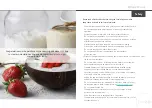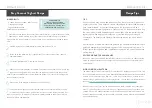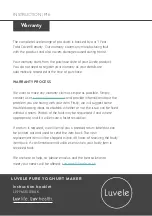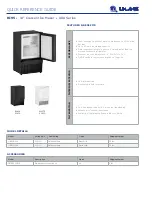
INSTRUCTION | P15
INSTRUCTION | P14
Cleaning
& Care
Hints & Tips
Cont.
Before disassembling and cleaning, ensure the power is switched off
at the power outlet, the power cord is unplugged from the power outlet
and the appliance is cool.
Remove the yoghurt maker’s outer lid from the top of the housing.
Remove the yoghurt container from inside the housing. Use a slightly damp,
soft cloth to wipe the housing. Dry thoroughly.
Wash the glass container and lid in warm soapy water. Rinse with water
and dry thoroughly with a soft, clean cloth. Do not use abrasive cleaners
or solvents as these may damage the appliance. Do not wash any part
of the yoghurt maker in the dishwasher.
Important - After each use, thoroughly dry the ‘heating element’
with paper towel or soft clean cloth.
Hints & Tips
Temperature Settings:
>
There are three temperature settings on the Luvele Pure Yoghurt Maker
36°C, 38°C, 40°C. All three temperatures can be used to make yoghurt
successfully. And all three temperatures can be used to make
SCD/GAPS diet yoghurt.
>
The reason we design the Pure Yoghurt Maker to have three temperature
settings it to provide more control over the end result of your homemade
yoghurt. Basically, incubating yoghurt at different temperatures can change
the taste and texture of the yoghurt. We recommend to start with the
38°C setting when making your first batch of yoghurt. Once you are
comfortable with the process, you can then start to experiment with
different temperatures.
>
Ensure the yoghurt container and other utensils used in the preparation
of the yoghurt are cleaned and rinsed under hot water, then dried with
a clean tea towel prior to use. This will help eliminate interfering
bacteria.
>
Ensure the ingredients to be used in the yoghurt mix are fresh.
Using out-of-date products will impede the production of thick
flavoursome yoghurt.
>
Follow suggested recipe quantities (see recipe on page 10) and methods
to ensure successful yoghurt production.
>
To avoid milk sticking or burning to the base of the saucepan when
heating, use a medium heat and stir continuously with a metal spoon.
Do not heat milk in the microwave.
>
After heating the milk, place the saucepan in a shallow, cold water bath
to speed up cooling. Use a sterilised kitchen thermometer to monitor
temperature of the milk when heating and cooling.
>
Avoid moving the yoghurt maker during the incubation period.
>
Do not use the yoghurt maker near a heat source, outdoors or in sunlight,
as exposure to excessive heat may make the yoghurt separate and
have a curdled appearance.
>
Refrigerate yoghurt for 8 hours before using. The texture and flavour
will improve with longer refrigeration.
For more amazing gut loving yoghurt recipes visit our recipe &
community blog at
www.luvele.co.uk
today.



























